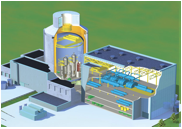| EPRI is assessing advanced light water reactor designs against existing water chemistry guidelines to determine whether guideline updates are needed.
EPRI developed and maintains a series of water chemistry guidelines for boiling water reactors (BWRs) and pressurized water reactors (PWRs) that define
water chemistry control and diagnostic parameters needed to assure materials and fuel-cladding integrity and minimize shutdown radiation fields.
Because these guidelines were written for the current generation of BWRs and PWRs, however, it is unclear whether they are equally applicable to
advanced light water reactor designs.
 |
|
In 2010, EPRI began assessing the chemistry control strategies planned for the advanced light water reactors, based on available design data, licensing
information, and operating experience (where it exists). These assessments are jointly sponsored by EPRI's Advanced Nuclear Technology and Water
Chemistry programs. In 2010, EPRI successfully piloted this effort with the GE-Hitachi/Toshiba ABWR (Report 1021091) and the Westinghouse AP1000
(Report 1021090) designs. Efforts are continuing in 2011, with assessments of the AREVA U.S. EPR, the Mitsubishi Heavy Industries U.S. APWR, and the
GE-Hitachi ESBWR.
The assessments of the GE-Hitachi/Toshiba ABWR and Westinghouse AP1000 revealed several differences between planned chemistry operations for these new
designs and the requirements or recommendations included in the current water chemistry guidelines. For example, in the AP1000, hydrogen is injected
directly into the coolant as opposed to being added via the volume control tank as in current generation PWRs; and all liquid samples from the AP1000
containment building go through a common header, making sampling requirements more challenging. For the ABWR, design specifications define limits for
reactor water iron and copper of less than 20 ppb and 1 ppb, respectively, while the EPRI guidelines do not include reactor water iron and copper as
control parameters. The differences identified in these assessments will be addressed in future projects - ultimately leading to water chemistry
guidelines that are applicable to the new plant designs.
For more information, contact Karen Kim at 650-855-2190 or kkim@epri.com.
|